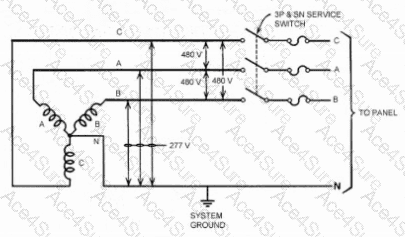Understanding the Diagram
The diagram shows a 480Y/277V three-phase, four-wire wye-connected system with a neutral (N) and system ground.
480 V = Voltage between any two phase conductors (line-to-line)
277 V = Voltage between any one phase conductor and neutral (line-to-neutral)
Fluorescent Lighting Voltage Requirements
Standard commercial fluorescent lighting systems are typically designed for 277 V operation in the U.S. (in buildings with a 480Y/277V system).
To achieve 277 V, you connect one phase conductor (A, B, or C) to Neutral (N).
This is a single-phase line-to-neutral connection.
Which Conductors to Use?
In the given options, the correct pair must give 277 V.
C, N → 277 V line-to-neutral → Correct for fluorescent lighting.
Other options produce different results:
A, B = 480 V (line-to-line) — too high for fluorescent ballasts.
C, A, B = all three phases — used for three-phase loads, not lighting.
C, A, N — would give two circuits, but includes extra phase unnecessarily for single-phase lighting.
NCARB ARE 5.0 PDD Study Guide References:
Content Area: Electrical Systems — Power Distribution and Circuiting for Lighting
Source References:
Electrical Systems for Architects — Fluorescent lighting voltage selection
MEEB (Mechanical and Electrical Equipment for Buildings) — Chapter on Electrical Service and Lighting Systems
NEC (National Electrical Code) — Voltage to ground for wye-connected systems
Key Point:
For a 480Y/277V wye system, fluorescent lighting should be connected from any phase to neutral for 277 V operation.

